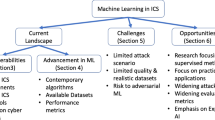Abstract
In this paper, we propose methods of handling, analyzing, and profiling monitoring data of energy systems using their thermal coefficient of performance seen in uneven segmentations in their time series databases. Aside from assessing the performance of chillers using this parameter, we dealt with pinpointing different trends that this parameter undergoes through while the systems operate. From these results, we identified and cross-validated with domain experts outlier behavior which were ultimately identified as faulty operation of the chiller. Finally, we establish correlations of the parameter with the other independent variables across the different circuits of the machine with or without the observed faulty behavior.











Similar content being viewed by others
References
Proklima International, Natural refrigerants: sustainable Ozone- and climate-friendly alternatives to HCFCs”, Technical Report, Deutsche Gesellschaft fr Technische Zusammenarbeit (GTZ) GmbH—German Technical Cooperation—Programme Proklima Dag-Hammarskjld-Weg 1-5 65760 Eschborn, Germany (2008)
Federal Ministry for the Environment, Nature conservation and nuclear safety, the international climate initiative of the Federal Republic of Germany, Federal Ministry for the Environment, Nature Conservation and Nuclear Safety (BMU) Public Relations Division 11055 Berlin, Germany (2009)
Dabrowski A (2001) Adsorption—from theory to practice. Adv Colloid Interface Sci 93:135–224
Jakob U, Mittelbach W (2008) Development and investigation of a compact silica gel/water adsorption chiller integrated in solar cooling system, VII Minsk international seminar: heat pipes, heat pumps, refrigerators, power sources, minks, Belarus, pp 8–11
Nunez T, Mittelbach W, Henning HM (2007) Development of an adsorption chiller and heat pump for domestic heating and air-conditioning applications. Appl Therm Eng 27:22052212
Liu YL, Wang RZ, Xia ZZ (2005) Experimental study on a continuous adsorption water chiller with novel design. Int J Refrig 28:218230
Liu YL, Wang RZ, Xia ZZ (2005) Experimental performance of a silica gel–water adsorption chiller. Appl Therm Eng 25(2—-3):359–375
Gong LX, Wang RZ (2012) Experimental study on an adsorption chiller employing lithium chloride in silica gel and methanol. Int J Refrig 35(7):19501957
Ayadi O, Aprile M, Motta M (2012) Solar cooling systems utilising concentrating solar collectors—an overview. Energy Procedia 30:875–883
Fong KF, Lee CK, Chow TT (2012) Comparative study of solar cooling systems with building-integrated solar collectors for use in sub-tropical regions like Hong Kong. Appl Energy 90:189–195
Bermejo P, Pino FJ, Rosa F (2010) Solar absorption cooling plant in Seville. Solar Energy 84:1503–1512
Zhai XQ, Wang RZ (2010) Experimental investigation and performance analysis on a solar adsorption cooling system with/without heat storage. Appl Energy 87:824–835
Helm M, Keil C, Hiebler S, Mehling H, Schweigler G (2009) Solar heating and cooling system with absorption chiller and low temperature latent heat storage: energetic performance and operational experience. Int J Refrig 32:596–606
Ayadi O, Mauro A, Aprile M, Motta M (2012) Performance assessment for solar heating and cooling system for office building in Italy. Energy Procedia 30:490–494
Baldwin C, Cruickshank C (2012) A review of solar cooling technologies for residential applications in Canada. Energy Procedia 30:495–504
Fong KF, Chow TT, Lee CK, Lin Z, Chan LS (2010) Comparative study of different solar cooling systems for buildings in subtropical city. Solar Energy 84:227–44
Tsoutsos T, Aloumpi E, Gkouskos Z, Karagiorgas M (2010) Design of a solar absorption cooling system in a Greek hospital. Energy Build 42(2):265–272
Ketjoy N, Yongphayoon R, Mansiri K (2013) Performance evaluation of 35 kW LiBr–H\(_2\)O solar absorption cooling system in Thailand. Energy Procedia 34:198–210
Boopathi Raja V, Shanmugam V (2012) A review and new approach to minimise the cost of solar assisted absorption cooling system. Renew Sustain Energy Rev 16:6725–6731
Hang Y, Qu M, Ukkusuri S (2011) Optimizing design of a solar cooling system using central composite design techniques. Energy Build 43:988–994
Joudi K, Abdul-Ghafour Q (2003) Development of design charts for solar cooling systems. Part I: computer simulation for a solar cooling system and development of solar cooling system design charts. Energy Convers Manag 44:313–339
Praene JP, Marc O, Lucas F, Miranville F (2011) Simulation and experimental investigation of solar absorption cooling system in Reunion Island. Appl Energy 88:831–839
Pelleg D, Moore A (2000) X-means: extending K-means with efficient estimation of the number of clusters. In: Proceedings of the seventeenth international conference on machine learning. Morgan Kaufmann, San Francisco, pp 723–734
http://www.kpwsolutions.com.au/media/brochures/KPW-Solutions-Cooling-Data-Sheets
Acknowledgments
The authors would like to thank Dan Pelleg and the Auton Lab of Carnegie Mellon University’s School of Computer Science for the implementation of X-Means used in this research.
Author information
Authors and Affiliations
Corresponding author
Rights and permissions
About this article
Cite this article
Malinao, J., Judex, F., Selke, T. et al. Pattern mining and fault detection via \(\textit{COP}_{\textit{therm}}\)-based profiling with correlation analysis of circuit variables in chiller systems. Comput Sci Res Dev 31, 79–87 (2016). https://doi.org/10.1007/s00450-014-0277-5
Published:
Issue Date:
DOI: https://doi.org/10.1007/s00450-014-0277-5




